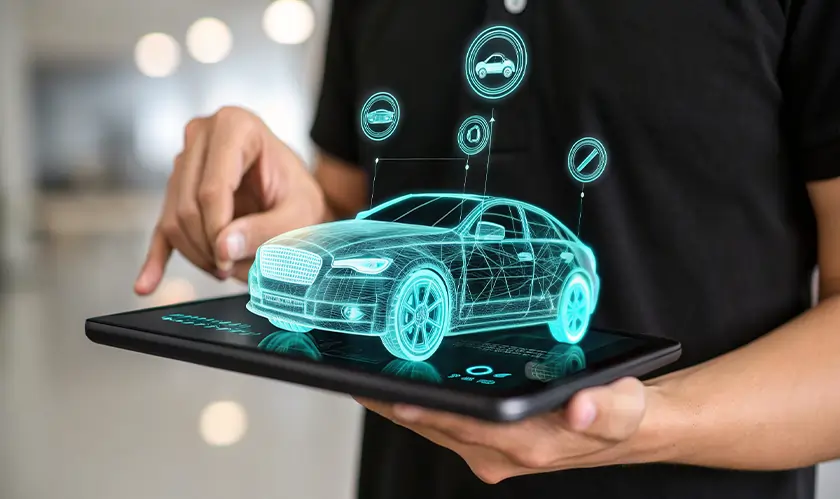Home Industry Automobile VR/AR for Automotive: Main Ben...
Automobile

CIO Bulletin
06 October, 2025
Virtual Reality (VR) and Augmented Reality (AR) are transforming industries worldwide, and the automotive sector is no exception. These immersive technologies are changing the way vehicles are designed, manufactured, marketed, and experienced by consumers. The integration of VR and AR into automotive processes offers numerous benefits, ranging from enhanced design accuracy to improved customer experiences. In this article, we will explore the main benefits of VR and AR in the automotive industry and how these technologies are shaping the future of automotive software development.
Before diving into the benefits, it’s essential to understand what VR and AR are:
Virtual Reality (VR): VR creates a completely immersive digital environment that can simulate real-world experiences or create entirely new ones. It typically requires a headset or special equipment to engage users in a 3D world.
Augmented Reality (AR): AR overlays digital information onto the real world, often through a device such as a smartphone or AR glasses. Unlike VR, AR doesn’t replace the real world; instead, it enhances it with digital elements that interact with physical surroundings.
These technologies are being leveraged in the automotive industry to enhance various processes, including design, manufacturing, marketing, and customer engagement.
One of the most significant advantages of VR and AR in the automotive sector is the enhancement of the vehicle design process. Traditionally, vehicle prototypes were designed and then physically built, often requiring significant time and resources. With VR and AR, automotive designers and engineers can now create and interact with virtual prototypes in real-time, speeding up the development cycle.
Virtual Reality allows designers to immerse themselves in 3D models of vehicles, allowing them to evaluate aesthetics, ergonomics, and functionality without the need for a physical prototype. This makes the design process faster and more cost-effective.
Augmented Reality enables designers and engineers to overlay digital elements onto physical prototypes. This allows for real-time analysis of how different parts will fit together and function, helping to identify potential issues early in the design process.
By leveraging VR and AR, automotive companies can reduce the time and cost associated with prototyping, while ensuring a higher level of design accuracy and precision.
VR and AR are also revolutionizing automotive manufacturing and assembly lines. These technologies enable a more streamlined, efficient, and error-free production process, improving the overall quality and consistency of the vehicles produced.
Virtual Reality can be used for worker training and simulation. Before employees step onto the assembly line, they can undergo extensive VR training to understand complex procedures and workflows. This reduces the chances of human error during the actual manufacturing process.
Augmented Reality can assist assembly line workers in real-time. AR glasses or headsets can display step-by-step instructions or highlight areas that require attention, helping workers follow precise instructions while keeping their hands free. This leads to faster assembly times and minimizes mistakes.
By integrating VR and AR into the manufacturing process, automotive companies can increase productivity, reduce errors, and improve overall product quality.
VR and AR are also reshaping how automotive companies market their vehicles and engage with customers. These technologies offer new and exciting ways to showcase vehicles and their features to potential buyers.
Virtual Reality allows potential customers to take virtual test drives, experiencing a vehicle from the comfort of their own home or a dealership. VR simulations can replicate driving conditions, giving customers a realistic sense of how a car handles on the road without the need for a physical test drive.
Augmented Reality can be used in showrooms and marketing materials to provide interactive experiences. For example, a customer can point their phone at a car in a showroom and view detailed specifications or even visualize different color options. AR can also be used in advertising campaigns, allowing users to interact with virtual cars in their own environment through their smartphones or AR glasses.
These mmersive experiences not only help customers make more informed purchasing decisions but also make the process more engaging and memorable. By using VR and AR, automotive companies can create a more personalized and innovative customer experience.
VR and AR are also proving valuable in the realm of vehicle maintenance and repairs. Automotive technicians can use these technologies to enhance their ability to diagnose and fix issues more efficiently.
Virtual Reality can be used for training technicians, allowing them to simulate and practice various repair scenarios in a controlled virtual environment. This can help technicians familiarize themselves with complex vehicle systems before working on real cars.
Augmented Reality can assist technicians during actual repair work. Using AR glasses, technicians can access real-time data, repair instructions, or even videos that guide them through complex repair procedures. This can speed up the repair process, reduce mistakes, and improve the accuracy of repairs.
By incorporating VR and AR into vehicle maintenance and repairs, automotive companies can enhance the skill set of their technicians, improve the accuracy of repairs, and ensure a more efficient service process for customers.
While VR and AR software development may require a significant upfront investment, the long-term benefits are substantial. These technologies streamline the development, manufacturing, marketing, and maintenance processes, ultimately leading to cost savings. By reducing the need for physical prototypes, speeding up training and assembly, and enhancing customer experiences, automotive companies can reduce operational costs and improve their bottom line.
VR and AR are transforming the automotive industry, offering numerous benefits that improve the entire lifecycle of a vehicle—from design and manufacturing to marketing and maintenance. By harnessing the power of these immersive technologies, automotive companies can create more innovative, efficient, and safe vehicles. Whether it’s designing vehicles more accurately, training employees more effectively, or enhancing the customer experience, the integration of VR and AR in the automotive sector is paving the way for a more advanced and user-centric future. As the technologies evolve, we can expect even greater advancements in automotive software development and beyond.







